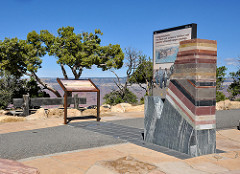Geologic Time Scale; History Of Life On Earth, Ch 6 Answers – Flashcards
Unlock all answers in this set
Unlock answersquestion
Geologic Time Scale

answer
A record of the geologic events and life forms in Earth's history.
question
Eras
answer
one of the three long units of geologic time between the precambrian and the present. (Eras: Palezoic, Mesozoic, Cenozoic)Mass extinctions mark boundaries between eras.
question
Periods
answer
unit of time into which eras on the Geologic Time Scale are subdivided
question
Precambrian
answer
name for the time in earths early history that accounts for ninety percent of earth's time, but only cellular organisms lived
question
Paleozoic Era
answer
it started with the cambrian explosion this is a time when a great number of organisms arose. During this time invertebrates developed along with vertebrates like fishes. Later animals began to reach land. Then the carboniferous period began and reptiles developed. Pangea formed and it ended with a mass extinction. This era lasted from 540 million years ago to 245 million years ago.
question
Mesozoic Era
answer
The period of geologic time, from 250 million to 65 million years ago, during which gymnosperms were the dominant plants and dinosaurs the dominant vertebrates. Ended with extinction of the dinosaurs. Also called Age of Reptiles.
question
Cenozoic Era
answer
The most recent period of geologic time, beginning 65 million years ago. during which mammals became the dominant vertebrates and angiosperms became the dominant plants. Also called Age of Mammals.
question
Invertebrate
answer
An animal lacking a backbone, such as an arthropod, mollusk, annelid, etc.
question
vertebrate
answer
an animal that has a backbone; includes mammals, birds, reptiles, amphibians, and fish
question
Mass extinction
answer
event in which many types of living things become extinct at the same time
question
Continental Drift
answer
The hypothesis that states that the continents once formed a single landmass, broke up, and drifted to their present locations
question
Evidence of Continental Drift
answer
-rock layers on coastlines of different continents match like a jigsaw puzzle, Land Features (mountain ranges on Africa and South America line up), Fossils (fresh water reptile fossils found on different sides of the world), Climate (fossils of tropical plants are now found on an island in the Arctic Ocean)
question
Pangaea
answer
According to scientific theory, a single landmass that broke apart to form today's separate continents; thought to have existed about 200+ million years ago.
question
plate tectonics
answer
A theory stating that the earth's surface is broken into plates that move.
question
fossil
answer
A preserved remnant or impression of an organism that lived in the past.
question
relative dating
answer
Method of determining the age of a fossil by comparing its placement with that of fossils in other layers of rock
question
absolute dating
answer
A technique used to determine the actual age of a fossil, they use the radioactivity in the rock.
question
extinct
answer
A term that typically describes a species that no longer has any known living individuals.
question
primate
answer
A group of mammals that have opposable thumbs, binocular vision and flexible shoulders
question
hominid
answer
characterizing the family Hominidae, which includes Homo sapiens as well as extinct species of manlike creatures
question
Homo sapiens
answer
A species of human which is the only surviving hominid.
question
neanderthals
answer
-used stone tools and buried the dead. They disappeared about 30,000 years ago.
question
australopithecines
answer
Any of several extinct humanlike primates that lived from about 4 million years ago to 750,000 years ago. The name means "southern ape", which refers to the area in Africa where they were primarily found. The most famous of the fossil remains was given the nickname of Lucy. They may have used stone tools and climbed trees.



